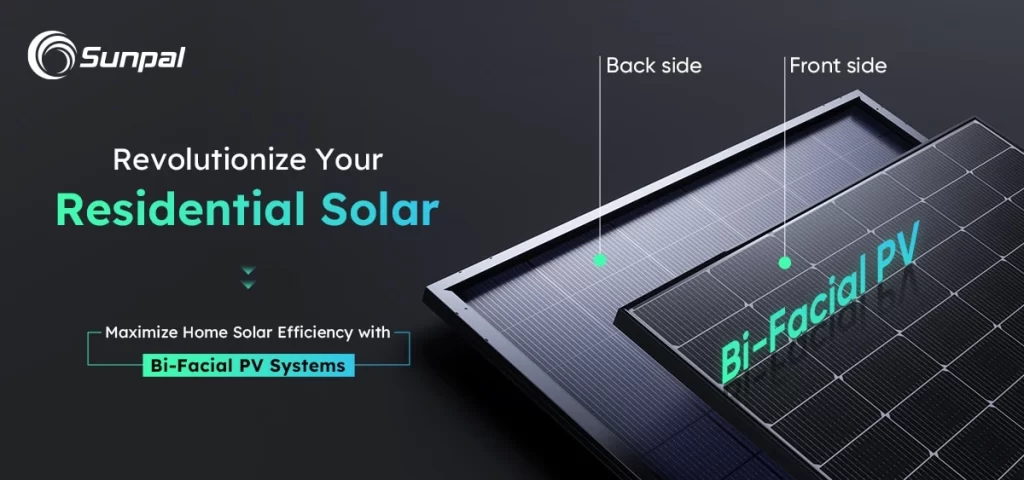
A Game-Changer for Home Solar Systems
Residential solar has entered a new phase of innovation — and it's being powered by bi-facial solar panels. Unlike traditional monofacial modules, which capture sunlight from only one side, bi-facial panels harvest energy from both the front and rear surfaces. This design captures direct sunlight on the front and reflected light (albedo) on the back, delivering up to 30% higher energy yields.
For homeowners, this means more electricity from the same rooftop space. For solar companies, it opens the door to more competitive system designs, faster ROI timelines, and stronger market positioning.
What Makes Bi-Facial PV Technology Different?
The principle behind bifacial photovoltaic systems is simple yet powerful: by using both sides of the solar cell, they capture light that would otherwise be wasted.
- Front Side: Captures direct sunlight as in conventional modules.
- Rear Side: Absorbs reflected light from surfaces below or around the installation.
Surfaces like light-colored rooftops, white gravel, concrete, or even snow can dramatically increase the amount of rear-side light captured. This “bonus” energy is what makes bi-facial systems so effective in residential settings.
Chart 1 – Annual Energy Output: Monofacial vs. Bi-Facial PV
| Panel Type | Average Annual Output (per kW) | % Gain vs. Monofacial |
| Monofacial | 1,500 kWh | — |
| Bi-Facial | 1,950 kWh | +30% |
This additional output helps homeowners generate more power without expanding their roof area, a critical advantage in space-constrained urban and suburban environments.
Higher Energy Yield = Faster Payback
In residential solar economics, return on investment (ROI) is everything. The faster a homeowner recoups the initial installation cost, the more attractive the system becomes.
Bi-facial panels significantly reduce the Levelized Cost of Energy (LCOE) by producing more kilowatt-hours over their lifetime. The result: payback periods that are two years shorter on average compared to monofacial systems.
Chart 2 – ROI Timeline and Lifetime Savings
| System Type | Avg. Payback Period | Lifetime Savings (25 yrs) |
| Monofacial | 7–9 years | $30,000 |
| Bi-Facial | 5–7 years | $42,000 |
For homeowners in reflective or snowy regions, these numbers can improve even further. This makes bifacial technology particularly appealing in North America, Europe, and parts of Asia where seasonal snow cover is common.
How Residential Solar Companies Benefit
It's not just homeowners who win with bi-facial technology — solar EPCs, distributors, and installers gain a competitive edge as well:
- Higher System Efficiency: More watts from the same footprint helps close deals in space-limited properties.
- Premium Offering: Differentiates installers from low-cost competitors using older tech.
- Better Long-Term Customer Satisfaction: Higher energy output means happier clients and stronger referral business.
With global bifacial module prices steadily falling, offering this premium option is becoming more financially accessible for solar businesses of all sizes.
Residential Solar Market Outlook for Bifacial Technology
The adoption curve for bifacial PV is steep. Market forecasts indicate double-digit growth in the residential segment through 2030, with the technology moving from niche to mainstream within the next five years.
Chart 3 – Global Residential Bifacial Solar Installations (2024–2030)
| Year | Estimated Installations (GW) |
| 2024 | 2.1 |
| 2026 | 4.8 |
| 2028 | 7.3 |
| 2030 | 10.5 |
This shift is driven by a combination of higher panel efficiency, falling manufacturing costs, and increasing homeowner awareness. As more countries push for net-zero energy targets, the return on investment gap between monofacial and bifacial systems will continue to widen in favor of bifacial.
Optimizing Bi-Facial Systems for Homes
To unlock the full potential of bifacial panels, residential installations must be designed with rear-side gain in mind. Key considerations include:
- Tilt Angle: Slightly steeper angles can improve rear-side exposure.
- Mounting Height: Raising panels increases the amount of reflected light reaching the rear side.
- Surface Selection: Light-colored or reflective surfaces under and around the panels can boost generation by 10–20%.
Proper system design can make the difference between a 10% and a 30% rear-side gain, so working with experienced installers is critical.
The Environmental Bonus
Aside from economics, bifacial technology also delivers environmental benefits:
- More Energy, Less Material Use: Higher output per panel reduces the number of modules required.
- Lower Carbon Footprint: Over its lifespan, a bifacial system offsets more emissions than a monofacial system of the same size.
- Extended Lifespan: Many bifacial modules are built with dual-glass construction, improving durability.
This means that bifacial systems contribute more to sustainable energy generation per square meter than any other residential solar technology available today.
Sunpal Solar's Role in the Bi-Facial Revolution
At Sunpal Solar, we're not just following the bifacial trend — we're leading it. Our bifacial module portfolio is engineered for maximum real-world performance, featuring:
- High bifaciality factors for optimal rear-side energy capture.
- Durability proven in diverse climates, from snowy Canada to sunny Australia.
- Optimized designs for both rooftop and ground-mounted residential applications.
- Comprehensive warranty and service support to ensure long-term reliability.
By integrating bifacial technology into residential projects, Sunpal helps homeowners achieve faster ROI, higher lifetime savings, and stronger environmental impact.
Conclusion: The New Benchmark in Home Solar
Bifacial solar panels are no longer an exotic option for utility-scale projects — they're now a practical, profitable, and environmentally superior choice for residential systems.
For homeowners, they mean lower energy bills, shorter payback periods, and increased property value. For solar businesses, they represent a competitive edge and a pathway to higher customer satisfaction.
As costs continue to fall and awareness grows, bifacial PV systems are set to become the new standard in residential solar. Those who embrace the technology now will be best positioned to capture its economic and environmental rewards.
